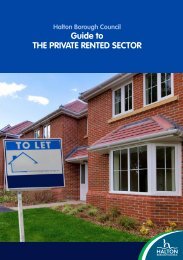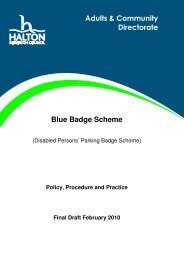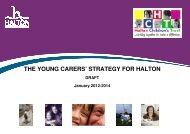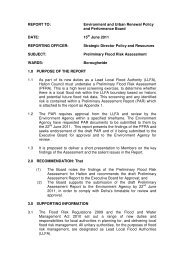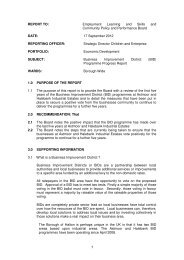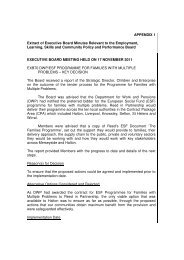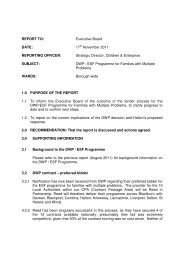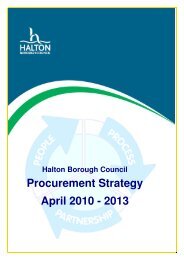App 2 - Halton Borough Council
App 2 - Halton Borough Council
App 2 - Halton Borough Council
- No tags were found...
You also want an ePaper? Increase the reach of your titles
YUMPU automatically turns print PDFs into web optimized ePapers that Google loves.
DraftIntegrated Adults Safeguarding UnitThresholds GuidanceJuly 20121
Thresholds GuidanceDue to the scale and varying needs of adult at risks it is crucial that all agencies workingwith adults at risk are involved in the prevention of abuse. However, identifying whensafeguarding referrals should be made is not always clear cut.In order to give some clarity to when a referral should be raised with <strong>Halton</strong> Adult CareServices, the following safeguarding referral “thresholds” have been compiled. Thisthreshold guidance is directed at providers/practitioners and aims to firstly ensure adultprotection issues and concerns are reported and investigated at the appropriate level,and secondly, to broker consistency of approach across agencies.It is recognised that some health organisations will conduct their own investigations,however, outcomes of those investigations must be forwarded to <strong>Halton</strong> IntegratedAdults Safeguarding Unit in order for them to fulfill their duty to monitor, and, recordsafeguarding referrals within the <strong>Halton</strong> locality.This guidance is laid out in 4 sections: - .Section 1 Safeguarding Referral Threshold Flowchart – lays out the basic processaround an Adult Safeguarding Referral.Section 2 Initial Considerations – what you need to consider before making a referral.Section 3a Threshold Tiers – gives written guidance around where Adult Safeguardingconcerns should be managed and when to refer in to <strong>Halton</strong> Adult Care Services.Section 3b Thresholds Matrix – a matrix laying out practical examples of what may fallin (or out) of the threshold for a safeguarding referral.Section 4 Risk assessment – gives written guidance in relation to assessing the level ofrisk involved.However, the message remains “if in doubt, report”.Submitting a Safeguarding ReferralIn order to submit a safeguarding adult referral, please contact <strong>Halton</strong> Adult Social CareServices Initial Assessment team on 0151 511 7676, who will advise how to make asafeguarding referral to <strong>Halton</strong> <strong>Borough</strong> <strong>Council</strong>.2
Section 1 - Adult Safeguarding Referral Threshold Flowchart (please also refer to Initial Considerations section 2)An adult at risk: :A person aged 18 or over and who:Assess risk & vulnerability andconsult Threshold Matrix• Is eligible for or receives any adultsocial care service (including carers’services) provided or arranged by alocal authority; or• Receives direct payments in lieu ofadult N social care services; or• Funds their own care and has socialcare needs; or• Otherwise has social care needs thatare low, moderate, substantial orcritical; or• Falls within any other categoriesprescribed by the Secretary of State;and Is at risk of significant harm,where harm is defined as ill treatmentor the impairment of health ordevelopment or unlawful conductwhich appropriates or adverselyaffects property, rights or interests(for example theft and fraud).Other ways for concern to bemanaged i.e. complaint,contract compliance, multiagency meeting, refer forassessment, human resourcesinvestigation etc.Is the person an adult at risk?YESHas the adult at risk cometo significant harm as aresult of an intentional orunintentional act or failureto act?YESMake a SafeguardingReferral to <strong>Halton</strong> SocialServicesNONOIs the incident part of apattern or trend?OrIs it likely that the incident(s)could recur leading to harmto an adult at risk?YESNO3No Safeguarding Referral Required
Section 2 Initial ConsiderationsThe flowchart in section 1 gives a diagrammatic illustration of the guidance in thissection.There are a number of actions/questions that need to be considered before completing areferral.a) Has the risk /vulnerability of adult at risk been assessed?(see section 4)b) Is the person who has/ may have been abused an adult at risk?For the purposes of this Threshold document and related documents, the definition of anadult at risk is as follows 1 :A person aged 18 or over and who: Is eligible for or receives any adult social care service (including carers’ services)provided or arranged by a local authority; or Receives direct payments in lieu of adult social care services; or Funds their own care and has social care needs; or Otherwise has social care needs that are low, moderate, substantial or critical; or Falls within any other categories prescribed by the Secretary of State; and Is at risk of significant harm, where harm is defined as ill treatment or theimpairment of health or development or unlawful conduct which appropriates oradversely affects property, rights or interests (for example theft and fraud).c) Has the adult at risk experienced significant harm? (see below for explanation of significantharm)Harm doesn’t necessarily mean physical harm, but could be emotional, physiological etc(see matrix for examples).If the answer to one or all of the above questions is “no” the alert will fall below thesafeguarding threshold. However, there are other possible ways in which your concernscan be managed. Examples include (although the list is not exhaustive): - Incident report logged Cause for concern logged Complaint Multi Agency Meeting / Care Management Contract compliance activity Signpost to relevant services Change in internal procedures/processes HR investigation Refer for relevant assessment Joint Contracts / Safeguarding planning meeting to address low level concerns /poor standards of care in relation to contracted providers1 Taken from the Law Commissions guidance document May 20114
d) Is there a duty of care which has been breached e.g. by a care worker or a carer?This helps distinguish abuse (of trust) from abusive/criminal acts by strangers.It is important to note that the abuse does not need to be deliberate. Some neglect is notdeliberate.It is not the intent which needs to be considered but the harm which has resulted froman act or omission and which should trigger adult safeguarding procedures.Explanation of Significant harmIn order to assess whether a referral meets the safeguarding adults threshold a decisionneeds to be made as to whether “significant harm” is likely to have occurred.Assessing - Significant harm varies between individuals and requires carefulassessment before a threshold decision is made, including consideration of thepossibility of future significant harm. The seriousness or extent of the abuse or neglect isoften not clear when the safeguarding issues is raised, some incidents may not havecaused immediate significant harm but if they were to recur it is highly likely that therewould be significant harm to the adult at risk, other adults at risk, or children.Because of the need for a timely response, information gathered to inform the thresholddecision cannot be as detailed as that gathered in a formal safeguarding adultassessment or investigation and should not delay a referral.No secrets refers to significant harm as:• ill treatment (including sexual abuse and forms of ill treatment which are not physical)’• the impairment of, or an avoidable deterioration in, physical or mental health and/or• the impairment of physical, intellectual, emotional, social or behavioural development.(web address for No Secrets document as follows)http://www.dh.gov.uk/en/Publicationsandstatistics/Publications/PublicationsPolicyAndGuidance/DH_4008486No secrets also puts forward the following factors to be taken into account when makingan assessment of the seriousness of the risk to the person:• Vulnerability of the person• Nature and extent of the abuse or neglect• Length of time the abuse or neglect has been occurring• Impact of the alleged abuse on the adult at risk• Risk of repeated or increasingly serious acts of abuse or neglect• Risk that serious harm could result if no action was taken• Illegality of the act or acts.5
Section 3a Threshold TiersLevel 2Investigated in house by careprovider.Outcome reported to <strong>Halton</strong><strong>Borough</strong> <strong>Council</strong> – IntegratedAdults Safeguarding Unit (IASU)Level 3Low to medium risk ofsignificant harm.Safeguarding referral to<strong>Halton</strong> <strong>Borough</strong> <strong>Council</strong>Complex Care Teams –reported to IntegratedAdults Safeguarding Unit(IASU)Level 1Managed through otherapproachesVulnerableAdult atthe CentreLevel 4Medium to high risk ofsignificant harm/serious casereview.Safeguarding referral to <strong>Halton</strong><strong>Borough</strong> <strong>Council</strong> IntegratedAdults Safeguarding Unit (IASU)7
Section 3a Thresholds LevelsThis section takes you through the different threshold tiers, of which there are 4. Thesection guides you through as to where concerns should be managed and when to referinto <strong>Halton</strong> Adult Social Care Services.Concerns falling within Level 1 and 2 should be dealt with in house by the managingagency. However, Level 3 and 4 must be put forward as a Safeguarding referral to<strong>Halton</strong> Adult Social Care Services.Level 1 – Single Agency ServicesMost adults at risk receive a variety of services from a range of providers. Theseservices generally provide good quality care and services and are often best placed todeal with many issues regarding allegations of abuse or poor practice. Therefore it isanticipated that most work on the lower levels of abuse should be dealt with internally bythese services.However, it is essential that all concerns about abuse are initially reported to <strong>Halton</strong>Adult Social Care Services.Level 2 - Complaints and Safeguarding Reviews.ComplaintsAll complaints regarding independent providers or other agencies should initially be dealtwith in-house by the agency internal complaints policy. It is anticipated most of thesecomplaints will be more about poor quality of care and service rather than abuse, forinstance low staffing numbers, environmental issues etc.It is good practice for providers to contact the agency who has placed an individual withthat service (where applicable) to inform them of any issues and the outcome of anyinternal investigations.ReviewsIt is the responsibility of the local authority and Primary Care Trust to annually review allthe adults at risk for whom they provide services to or arrange placements for.The purpose of the review is to look at whether an adult at risk needs are being met.Reviews would, where a case does not meet the criteria of significant harm, addressedabuse issues and thus prevent the abuse potentially escalating.Level 3 – Low to Medium risk of significant harm (Complex Care Teams)Level 3 and above is the point at which safeguarding referrals should be raiseddirectly with <strong>Halton</strong> Adult Care ServicesThe relevant Complex Care teams within <strong>Halton</strong> Adult Social Care Services will take theinitial lead regarding the coordination of the allegation of abuse and chair all themeetings relating to the allegation.Level 3 involves cases of low to medium levels of harm, examples of which include:Physical abuse – e.g. where an adult at risk has experienced a physical injury, exceptwhere this is of a serious nature i.e. Neglect – e.g. where a relative is neglecting theadult at risk or friend, for example if a partner refuses to pay for care for the adult at risk.Psychological abuse – e.g. where an adult at risk is being bullied either by neighbours /friends / relatives / strangers – treatment which undermines dignity, not recognising andadults choice or opinion etc.Discriminatory abuse – e.g. where the adult at risk is being ridiculed or threatenedbecause of their race, gender, disability, sexuality, religion or age.8
Level 4a – Medium to High risk of significant harm/serious case review (IntegratedAdults Safeguarding Unit)Level 4a is where the adult at risk faces a higher level of risk of significant harm i.e.threats to kill, rape etc. These complex cases meeting the threshold for safeguardinginvestigation will be investigated by the Integrated Adults Safeguarding Unit.Consideration should also be given at this level as to whether the case needs to bereferred for a serious case review.Cases in this level involve complex situations for example:o Legalo Multiagencyo Nursing and residential homes- multiple abuse allegationsLevel 4b - Serious Case ReviewSerious case reviews conducted under the Adult Safeguarding Procedures arecommissioned specifically by the <strong>Halton</strong> Safeguarding Adults Board; it is to this body that theserious case review finally reports. The responsibility for the decision to commission anSerious case review therefore lies with the Chair of the <strong>Halton</strong> Safeguarding Adults Board, orin that person’s absence, their nominated deputy.A serious case review will be considered when: A vulnerable adult dies (including death by suicide), and abuse or neglect is knownor suspected to be a factor in their death A vulnerable adult has sustained any of the following:o a life threatening injury through abuse or neglecto serious sexual abuseo serious and/or permanent physical or emotional harm arising from the abuseor, where serious abuse occurred in an institutional setting:o a culture of abuse was identified and/oro multiple abusers were involvedANDThe cases(s) give rise to concerns about the way in which local professional and serviceswork together to safeguard vulnerable adults A significant “near miss” has taken place – in these situations, nothing serious mayhave happened but there is evidence of significant weakness in the way localprofessionals and services work together to safeguard vulnerable adults. This willalso include cases where there is an on-going accumulation of concern.9
Type ofAbusePhysicalLevel 1Managed through otherapproaches• Staff error causing little or noharm, eg friction mark onskin due to ill-fitting hoistsling• Minor events that still meetcriteria for ‘incidentreporting’Level 2Investigated in house butoutcome reported to <strong>Halton</strong><strong>Borough</strong> <strong>Council</strong> - IASU• One off incident involvingservice user on service user• Inexplicable marking found onone occasionLevel 3Low to medium risk ofsignificant harm.Safeguarding referral to<strong>Halton</strong> <strong>Borough</strong> <strong>Council</strong> -Complex Care Teams –outcome reported to IASU• Inexplicable marking or lesions,cuts or grip marks found on morethan one occasion.• Marks lesions, cuts caused byone person but to several serviceusers.Level 4aMedium to high risk ofsignificant harm.Safeguarding referral to<strong>Halton</strong> <strong>Borough</strong> <strong>Council</strong> - IASU• Inappropriate restraint• Withholding of food, drinks oraids to independence• Inexplicable fractures/injuries• AssaultLevel 4bSerious case review.Safeguarding referral to<strong>Halton</strong> <strong>Borough</strong> <strong>Council</strong> -IASU• Grevious bodily harm/assaultrequiring hospital admissionMedication• Adult does not receiveprescribed medication(missed/wrong dose) on oneoccasion - no harm occurs• Occasional incidents of missedmedication or administrationerrors in relation to one serviceuser that causes no harm• Recurring missed medication orerrors that affect more than oneadult and/or result in harm• Missed medication where harmdoes occur• Deliberate maladministration ofmedications• Covert medication withoutproper medicalauthorisation/supervision• Pattern of recurring errors or anincident of deliberatemaladministration that results inill-health or deathNeglect andActs ofOmission• Isolated missed home carevisit where no harm occurs• Adult is not assisted withfood/drink, personal careneeds, toileting, pressurearea care and moving &handling on one occasionand no harm occurs• Inadequacies in care provisionthat lead to discomfort orinconvenience - no significantharm occurs e.g. being left wetoccasionally• Not having access to aids toindependence• Low level neglectful practice iefailure to refer to necessaryagencies where this is not partof their professionalaccountability and wheretraining has not been provided• Recurrent missed home carevisits where risk of harmescalates, or one miss whereharm occurs• Hospital discharge withoutadequate planning and harmoccurs• Self neglect• Partner refusing to pay for care• On-going lack of care that causeshealth and wellbeing todeteriorate significantly eg.avoidable malnutrition,dehydration, pain, loss of dignity,tissue viability problems• Failure to arrange access to lifesaving services or medical care• Failure to intervene indangerous situations where theadult lacks the capacity to assessrisk11
Type ofAbusePsychologicalInstitutionalSexualLevel 1Managed through otherapproaches• One off incident where anadult is spoken to in a rudeor inappropriate mannerresulting in respect beingundermined but no or littledistress is caused• Lack of stimulation oropportunities for adults toengage in social and leisureactivities• Lack of person-centredapproach where serviceusers are not given asufficient voice or supportedto be involved in the deliveryof the service• One off incident when aninappropriate sexualisedremark is made to an adultand no or little distress iscausedLevel 2Investigated in house butoutcome reported to <strong>Halton</strong><strong>Borough</strong> <strong>Council</strong> - IASU• Occasional taunts, teasing orverbal outbursts which causedistress• The withholding of informationto disempower an individual• Care-planning documentationnot person-centred• One off incident of low-levelunwanted sexualisedattention/touching directed atone adult by another whetheror not capacity existsLevel 3Low to medium risk ofsignificant harm.Safeguarding referral to<strong>Halton</strong> <strong>Borough</strong> <strong>Council</strong> -Complex Care Teams –outcome reported to IASU• Frequent taunts, verbaloutbursts• Treatment that underminesdignity and damages esteem• Denying or failing to recognisean adult’s choice or opinion• Humiliation• Bullying/intimidation• Rigid/inflexible routines• Service user’s dignity isundermined e.g. lack of privacyduring support with personalcare needs• Denial of individuality andopportunities for service users tomake informed choices and takeresponsible risks• Staff misusing their position ofpower over service users• Recurring verbal sexualisedteasing• Sexual harassmentLevel 4aMedium to high risk ofsignificant harm.Safeguarding referral to<strong>Halton</strong> <strong>Borough</strong> <strong>Council</strong> - IASU• Emotional blackmail e.g. threatsof abandonment/harm, threatsto kill• Frequent and frightening verbaloutbursts• Care/support plans and riskassessments not followed orneeds not specified or met asspecified – recurring event that ishappening to more than oneadult and results in harm• Bad practice not being reportedand going unchecked• Recurring sexualised touch orisolated/recurring masturbationwithout consent• Attempted penetration by anymeans (whether or not it occurswithin a relationship) withoutconsentLevel 4bSerious case review.Safeguarding referral to<strong>Halton</strong> <strong>Borough</strong> <strong>Council</strong> -IASU• Denial of basic humanrights/civil liberties, overridingadvance decisions• Vicious/personalised verbalattacks• Inappropriate chemical orphysical restraint used tomanage behaviour• Widespread, consistent illtreatment• Sex in a relationshipcharacterised by authority,inequality or exploitation e.g.staff and service user• Sex without consent/rape12
Type ofAbuseFinancialLevel 1Managed through otherapproaches• Staff personally benefit fromthe support they offer theirservice users eg whenshopping use ‘buy one getone free offers’Level 2Investigated in house butoutcome reported to <strong>Halton</strong><strong>Borough</strong> <strong>Council</strong> - IASU• Adult not routinely involved indecisions about how theirmoney is spent• TheftLevel 3Low to medium risk ofsignificant harm.Safeguarding referral to<strong>Halton</strong> <strong>Borough</strong> <strong>Council</strong> -Complex Care Teams –outcome reported to IASU• Adult denied access to ownfunds/possessionsLevel 4aMedium to high risk ofsignificant harm.Safeguarding referral to<strong>Halton</strong> <strong>Borough</strong> <strong>Council</strong> - IASU• Personal finances illegallyremoved from adult’s control• Misuse/misappropriation ofproperty, possessions or benefitsby a person in a position of trustor controlLevel 4bSerious case review.Safeguarding referral to<strong>Halton</strong> <strong>Borough</strong> <strong>Council</strong> -IASU• Fraud/exploitation relating tobenefits, income, property orwillDiscriminatory• Isolated incident when aninappropriate prejudicialremark is made to an adultand no or little distress iscaused• Care planning fails to addressan adult’s diversity associatedneeds for a short period• Isolated incident of harassment• Recurring failure to meet anadult’s diversity associated needs• Inequitable access to serviceprovision as a result of a diversityissue• Recurring taunts• Being refused access to essentialservices as a result of a diversityissue• Hate crime resulting ininjury/emergency medicaltreatment/fear for life• Hate crime resulting in seriousinjury or attemptedmurder/honour-based violence13
Section 4 – Risk AssessmentThe governing principle behind good approaches to choice and risk is that people have theright to live their lives to the full as long as that does not stop others to doing the same. Fearof supporting people to take reasonable risks in their daily lives can prevent them from doingthe things that most people take for granted.What needs to be considered is the consequence of an action and the likelihood of any harmfrom it.Principles1. Risk is an unavoidable part of life and it is neither possible nor desirable to remove all riskfrom the experience of service users.2. In exercising their professional judgement, all staff will act within the law and inaccordance with the Directorate’s policies and procedures and in doing so will receivesupport from the Directorate whatever the eventual outcome.3. Risk assessment and management involves close work with service users and carers toagree: -• The likelihood of positive and negative outcomes• Service user and / or support system strengthsDefinitions:Hazard: factors which make harm more likely to occur. These factors may stem from theperson themselves, their environment or from other people.Risk: the likelihood of harm actually occurring. Risk may also be an opportunity togain potential benefits and improve quality of life.Harm is the ill treatment (which can include all forms of abuse) and the impairment of, or anavoidable deterioration in, physical or mental health; and the impairment of physical,intellectual, emotional or behavioural development.Risk Assessment: assesses the likelihood of actionsleading to positive or negative outcomes and the relativesignificance of these outcomesRisk Management: a system for implementing, controllingand learning from risk decisionsRisk-taking is choosing to act or not to act in relation to assessed risk.Levels of Risk:Moderate/LowThe risk of harm is easily resolved through provision of services.Where any harm that results (physical or psychological) would not require professionalsupport (medical, clinical, oncall, etc).SubstantialPhysical injury to self or others, which would require medical attention (GP, A & E, etc).Psychological trauma, which impinges on the service user’s or others’ quality of life andsense of wellbeing and would require professional support.Potential breakdown of current placement.CriticalPhysical harm or psychological trauma to self or others which would require admission tohospital.14
DeathBehaviour that would result in criminal prosecution andimprisonment or sectioning under the Mental Health Act.Residential admissions and out of area placementsLevels of risk assessmentA Level 2 risk assessment will not be required in respect of every service user. The sameanalytical process should be used for all levels but will not be needed at so much depth ordetail in less complex situations. Care Managers will need to use their judgement in order todecide at which level a risk assessment should proceed.There are two basic levels of risk assessment:Level 1Risk assessment should form part of all assessments and must be recorded with the maindocumentation.Level 1 will apply in situations where most risks are eithermoderate/low or well managed but where a specific decision has to be made that involvessome risk of harm or risk to loss of independence.Level 2Level 2 risk assessments should be carried out where the member of staff has a reasonableexpectation that a service user’s present or planned situation is likely to present a significantrisk to themselves or others.These are likely to be situations where a number of risks are present and where at least oneor two of these are substantial or critical – i.e. have a medium or high likelihood and amedium or high outcome of severity.Risk assessment at all levels should consider three vital issues:HISTORY i.e. previous serious or potentially serious events that have occurred.RISK FACTORS i.e. current factors that may affect risks.SIGNIFICANCE OF RISK i.e. the likelihood of the risk occurring and the severity of itsconsequences.This analysis should be followed by aDECISION MAKING PROCESS AND OUTCOME which is recorded and is followed by theRISK MANAGEMENT PLAN i.e. how risks can be managed at an acceptable level.TimescalesRisk is dynamic and usually depends on circumstances that can alter over brief time periods.Therefore risk assessment needs a predominantly short-term perspective and must besubject to regular review.Level 2 Risk Assessments must be reviewed after 6 weeks and consider the effectiveness ofthe risk management plan and the processes of managing this within Provider Services. Ifthe risk management plan is working, the review timescale can move to 12 monthly unlessthere is a change in risk levels.15
Completing a Level 2 Risk Assessment within the Safeguarding Adults procedures:Type of RiskIdentify here the original risks of harm, which may change when protective action is taken.For example, original risk of harm is rape, but the current risk is much less if the personcausing harm is arrested.Detail in this section the how bad and how often and think wider than the presenting issue.For example, financial abuse increases an individual’s risk of neglect, risk of adequate foodor heating and possible eviction.Also consider in this section, the risk of harm to other adults at risk. For example, oneperson experiencing abuse due to inappropriate use of restraint may be an indicationof institutional abuse affecting more people. When considering risk of harm, alwaysrecord the individual’s awareness and perceptions of the risks.Factors that increase risk of harmThere are a number of personal and environmental factors which will contribute to anindividual’s risk of harm. They include:Age. Research shows people are significantly more likely to be abused if you are aged over70 years of age.Physical disability. Increase physical dependency on other for help with day-to-day livingmakes people more vulnerable to abuse.Learning disability. Adults with learning disabilities may not understand acceptable levelsof support or may be in situations where abuse from other service users is more likely andcommunication difficulties may mean reporting abuse difficult.Mental Health Issues. Research has shown that people with mental health illnesses oftenare not believed or find themselves in situations where abuse from other service users ispossible.Sensory impairments. Individual’s sensory impairments may make reporting abuse difficultor identifying the abuser difficult.Dementia. It is particularly important to assess individual’s mental capacity.Ethnicity/ culture. If English is not the person’s first language – reporting abuse may bedifficult. It is particularly important to use independent interpreters to aid communication –never use family members.Social isolation. If a person has limited family or social networks they will have less externalscrutiny to identify any signs of abuse or mistreatment.Previous victim of abuse. Victims of abuse often have low self-esteem and or a beliefsystem supporting abusive behaviour as a legitimate response to situations.Communication difficulties. Where necessary independent professional who can facilitatecommunication must be used.Previously the person causing harm. Those who previously were the person causingharm who then become dependent on their previous victims may be at risk of abuse with‘revenge’ as the motivation.Health problems. Individual health problems may make them too weak to report or respondto abuse.Domestic abuse. Research shows that domestic abuse is most commonly experienced bywomen and carried out by men. Women with disabilities are twice as likely to experiencegender based violence as non-disabled women, and are likely to experience abuse over alonger period of time and suffer more severe injuries as a result.Service providers. If an individual is receiving community care services, the actions of theprovider may have an impact on the individual. Especially if there is no current manager,16
new manager, high staff turnover, high proportional of agency staff, large number of peoplewith high level of needs, little or no staff training.When considering factors that increase the risk of harm, always record theindividual’s views.Factors that decrease the risk of harmIdentify the protective factors that are in place or which have been put in place as a result orthat can be immediately be put in place to reduce or eliminate the risk of harm. This shouldinclude any immediate/ emergency Protection Plans put in place by any agency. Forexample:Support services in place (domiciliary care package, 1:1 support)Relationships with family, friends, neighbours, which do not present a riskAccess to social/ support groupsAwareness of personal supportServices recognise abuse and has taken appropriate actionPerson is in a place considered to be safeSignificance of RiskThis section should be completed for each area of risk identified At all levels of assessment,the significance of any risk should be quantified, according to the scheme set out below.There are two fundamental factors to consider when calculating the significance of aparticular risk. These are:- the likelihood of the risk occurring in the periodcovered by the risk assessment.- the severity of its consequences.When arriving at a likelihood estimation, there are several important considerations whichyou will have already looked at in your assessment:- Is there any known history to this particular risk?- How often has it occurred in the past and with what frequency?- Are there any known triggers and are they likely tooccur within the risk period?Likelihood should be measured as HIGH, MEDIUM or LOW according to the followingcriteria:1 Unlikely to happen in the next six months. LOW2 Evens (50%) chance of happening in the next six months. MEDIUM3 More than 50% chance of happening in the next six months. HIGHThe severity of the risk should also be measured as CRITICAL , SUBSTANTIAL orMODERATE/LOW according to the following criteria:1. Moderate / Low• The risk of harm is easily resolved through provision of services.• Where any harm that results (physical or psychological) would not requireprofessional support (medical, clinical, on-call, etc).17
2. Substantial• Physical injury to the service user or others which would require medical attention(GP, A & E, etc).• Psychological trauma which impinges on the service users or others’ quality of lifeand sense of wellbeing and would require professional support.• Potential breakdown of current placement.3. Critical• Physical harm or psychological trauma to self or others which would requireadmission to hospital.• Death• Behaviour which would result in criminal prosecution and imprisonment or sectioningunder the Mental Health Act.• Residential admissions and out of area placementsSignificance is then obtained by the idea of multiplyingthese two factors.Significance = likelihood x severity.This will be straightforward where the two factors are the same i.e. both the likelihood andthe severity are either HIGH, MEDIUM or LOW, but will require more judgement where thefactors are different, so a high likelihood and a medium severity or a medium likelihood anda low severity would need a judgement as to whether this ultimately falls into the substantialor the moderate/low category. It is expected that areas of concern that have critical orsubstantial significance will be transferred into the Risk Management PlanRisk Management PlanHaving identified significant risks and agreed on what decisions have been made it isessential to explain how any risks are to be managed and minimized. This should be asdetailed as possible.NB If the assessment of risk has shown that the risks are less significant than was at firstthought, then this plan could be written on the standard care plan documentation. A separaterisk management plan is only required if the risk is likely to remain substantial or critical afterthe usual assistance to manage risk has been given.18
<strong>App</strong>endix 1: Level 2 Risk Assessment FormRISK ASSESSMENT AND MANAGEMENT PLANLEVEL 21. Identification Details Care First No:Name:Date of BirthAddress:Postcode:2. Main Carer3. What are the hazards present in this person’s situation?4. Previous incidents relating to harm or loss of independence5. Previous risk assessments19
6. Circumstances that will influence risk7. Areas of ConcernSignificance = likelihood × severityCritical Substantial Moderate/LowN.B.Very high risks to be identified by Panel and logged with the Operational Director8. Analysis of risk behaviour20
9. What are the benefits of any proposed intervention? What is the effect onindependence? In what ways will harm be reduced?10. Does the service user/ carer understand that there is a risk? Does a capacityassessment need to be undertaken?11. Legal issues considered:12. Who has been involved ( service user, carer, friends, other professionals)?13. Service User’s Comments14. Following this assessment if a specific decision has been made record here:15. Assessor /Manager/Panel comments:21
16. Risk Management PlanIdentified risk Action to manage risk ResponsiblepersonIn what ways do the actionsreduce the risk to the person?Residual Risks i.e. risks remainingafter risk management measuresput in place17. Monitoring /Review/Emergency ArrangementsThe plan will be monitored /reviewed by: Date of ReviewContingency Plan in case of emergency22
I understand and agree to the risk management planService user/carer signature:Date:( if unable to sign state why)Assessor’s signature: Date:Principal Manager signature: Date:Divisional Manager signature: Date:Signature of Panel Chair Date:23
Case ExamplesLevels of RiskModerate/LowThe risk of harm is easily resolved through provision of services.Where any harm that results (physical or psychological) would not require professionalsupport (medical, clinical, on-call, etc).SubstantialPhysical injury to the service user or others which would require medical attention(GP, A & E, etc).Psychological trauma which impinges on the service users or others’ quality of lifeand sense of wellbeing and would require professional support.Behaviour which may lead to breakdown of current placement.CriticalPhysical injury (including death) to the service user or others which would require theiradmission to hospital.Psychological trauma to the service user or others which would require their admission tohospital.Behaviour which would result in criminal prosecution and imprisonment or sectioning underthe Mental Health Act.For example:Falls• Moderate/Low risk may be that the person falls periodically, but has neverdone any real damage to themselves, and carries a pendant alarm. They havecapacity to use the alarm and have contact from a relative on a daily basis whowould report back any lack of contact.• Substantial risk – In this situation the falls become more frequent (and cannotbe prevented). They have caused long lasting skin abrasions. However, thealarm is still carried and the daily monitoring system is still in place to keepthe risk to this medium level.• Critical Risk – The falls continue to be frequent and unpreventable. Thelatest resulted in admission to hospital and the service user has becomesomewhat confused and forgetful. They wish to return home but is likely toforget to carry the alarm or not realise to press the button if they do fall.Nutrition• Moderate/Low Risk – The person does not eat properly but there is no health risk.The person lives in sheltered housing and receives Home Care so the situation canbe monitored.• Substantial Risk – The person does not eat properly and although there is noevidence of health risks, they are socially isolated and refuse services.• Critical Risk – The person is diabetic, has memory problems and forgets toeat. Their poor diet has serious implications for their health and has already24
esulted in one admission to hospital.Smoking /Fire Risk• Moderate/Low Risk – The person doesn’t put their cigarettes out properly.They drop hot ash onto themselves but this hasn’t resulted in any injuries.• Substantial Risk - The person drops lit cigarettes onto themselves. This hasresulted in minor burns needing treatment in A&E and damage to furniture.• Critical Risk – The person has dementia and wanders with lit cigarettes. Thishas already caused a fire in their bedroom which resulted in their admission tohospital due to inhaling smoke.Safety• Moderate/ Low Risk – The person lives in residential care and has dementia. Has atendency to wander around the building.• Substantial Risk - The person attempts to leave the building . Staff bring them backand manage to reassure• Critical Risk: - The person has a history of violence and become very aggressivetowards staff when they try to prevent them from leaving the building. They throwfurniture and frighten other service users.25





